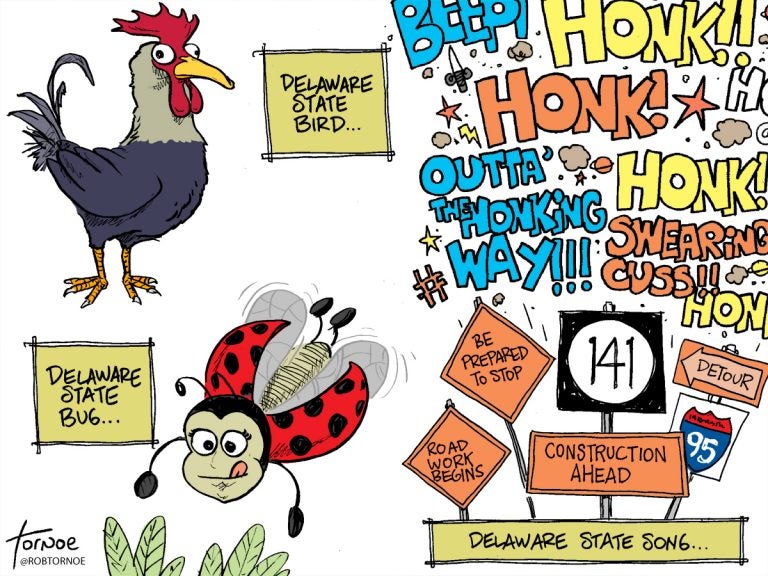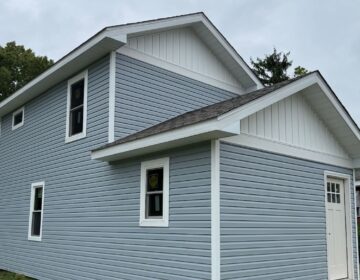In Delaware, traffic problems always occur
When I was first dating my wife, we lived in northern New Jersey and I would promise her that once we moved back to Delaware, all our traffic woes would disappear.

(Rob Tornoe/for WHYY)
When I was first dating my wife, we lived in northern New Jersey and I would promise her that once we moved back to Delaware, all our traffic woes would disappear.
“It took me 15 minutes to commute. It’s amazing!” I’d tell her, which in 2006 was mostly true. Today it’s a different story.
These days I find myself checking Google Maps to see real-time traffic data ever time I get into my car, regardless if I’m driving to my day job in Philadelphia or just crossing town to buy some milk and a loaf of bread.
Construction on I-95 regularly backs up traffic across the Delaware Memorial Bridge into Delaware (which I was able to experience firsthand last weekend). Work on the intersection between I-95 and Del. 141 feels like its gone on since Peter Minuit first landed his ships in Wilmington. New work on Del. 141 between Alapocas and Prices Corner will be causing headaches at least through the spring of 2019. The U.S. 301 extension should be a godsend when it’s completed in December 2018, but until then endless detours and increasingly-annoying backups will be the norm in Middletown.
You get the picture.
Look, my intention isn’t to beat down on DelDOT, which I think is doing the best it can with our aging infrastructure. In fact, some of the work is intended to not only make driving easier and safer for commuters, but to also decrease DelDOT’s yearly maintenance costs. And certainly Delaware’s population growth, which outpaces other Northeastern states, contributes mightily to the problem.
But that doesn’t mean I can’t pound my fist in anger when I’m waiting in a sea of red on Route 1 near the mall, a traffic problem years of construction was supposed to help clear up. Yes, the intention was to alleviate back-ups on the I-95 side of the interchange, but I expected more than just a shift in traffic less than a quarter-mile south.
I get it, working on these roads is complicated business and creates logistical nightmares for the engineers attempting the impossible task of keeping motorists happy. And everyone, including me, has an opinion about what DelDOT should fix next.
But there are steps the state can take to give DelDOT the resources it needs to complete these projects as quickly and efficiently as possible. First up would be getting rid of the Community Transportation Fund, a slush fund given to every legislator in the state intended for repairs in their individual districts. Instead, the money has gone to things like all-terrain-vehicles for fire companies, a pier reconstruction for the Kalmar Nyckel tall ship, and fences around private property.
Then there’s the gas tax, which Gov. Jack Markell wasn’t able to increase his tenure in office. So far, Gov. John Carney seems inclined to stay pat, despite the fact Delaware has the lowest gas tax on the East Coast ($0.23 per gallon) which hasn’t been increased since 1995. Motorists didn’t really blink an eye when gas prices fluctuated following the hurricanes in Florida and Texas, and an increase of just $0.10 a gallon could raise an extra $50 million a year for infrastructure projects.
The alternative is continuing to allow DelDOT to remain hostage to our insane, last-minute budget process, now complete with annual revenue shortfalls. This forces DelDOT to play catch-up instead of truly being able to plan, develop and execute proper infrastructure plans that would create the least impact on drivers.
But if you’re stuck in traffic this holiday season, I do have a tip for you: try honking again.
Rob Tornoe is a cartoonist and a WHYY contributor. Follow Rob on Twitter @RobTornoe
WHYY is your source for fact-based, in-depth journalism and information. As a nonprofit organization, we rely on financial support from readers like you. Please give today.





